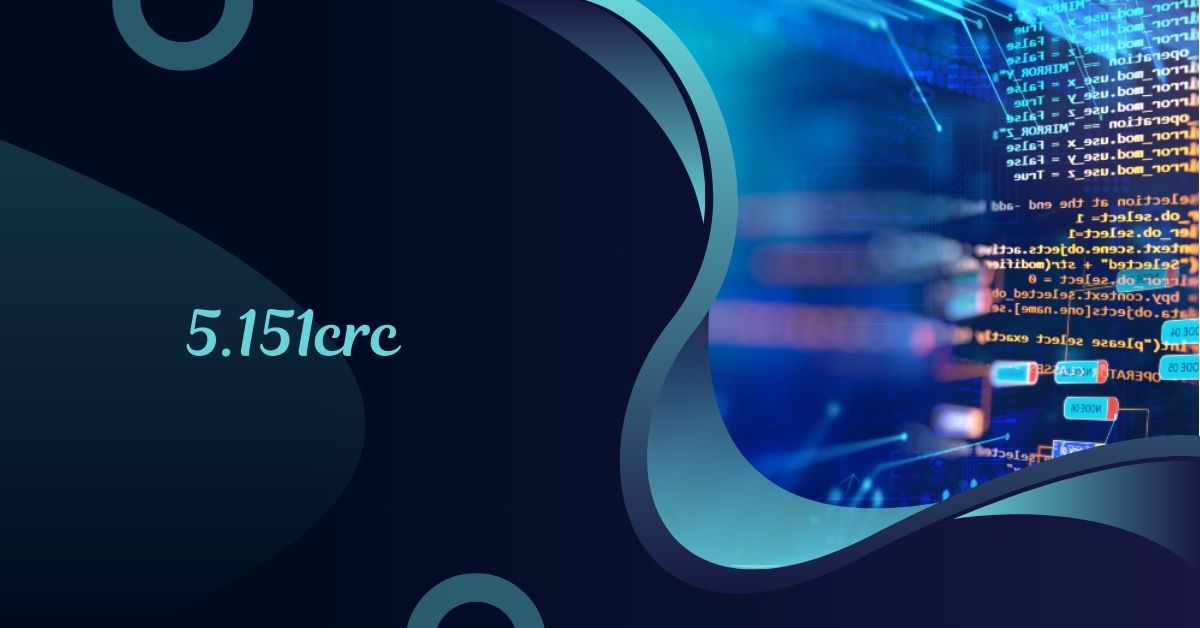In today’s digital world, data integrity is paramount. One way to ensure that data remains accurate during transmission and storage is through methods like the Cyclic Redundancy Check (CRC).
The term 5.151crc specifically refers to a variant of this technology, incorporating error-checking capabilities into various computing processes. In this article, we will delve deeply into what 5.151crc is, its significance, and how it is applied in real-world scenarios.
What is 5.151crc?
The 5.151crc code is a specific identifier within the larger family of CRC algorithms. The acronym CRC stands for Cyclic Redundancy Check, a method widely used in data communications and storage systems to detect accidental changes to raw data. Here’s a breakdown of its components:
What Does “CRC” Mean?
The CRC is an error-detecting code that checks for changes to raw data. It generates a short, fixed-length binary sequence from a block of data, which can be sent along with the data itself. When the data is received, the CRC is recalculated, and if the two CRC values match, it is highly likely that the data is intact.
The “5.151” Part
The number 5.151 likely refers to a specific version of the CRC algorithm. Different versions of CRC can vary in their polynomial representations, error detection capabilities, and overall efficiency. Understanding the version number is crucial because it can affect how well the CRC can detect errors.
The Importance of 5.151crc
In computing, error detection is critical. Data corruption can lead to significant issues, including system failures, data loss, and even security vulnerabilities. Here’s why 5.151crc is important:
1. Ensuring Data Integrity
The primary purpose of 5.151crc is to ensure that the data remains unchanged during transmission. This is crucial in various fields, including finance, healthcare, and communications, where the accuracy of data is vital.
2. Enhancing Reliability
With 5.151crc, systems can identify errors before they cause larger problems. This reliability is essential for applications that require high availability and uptime, such as cloud services and enterprise applications.
3. Streamlining Data Transmission
Using CRC algorithms like 5.151crc helps to minimize the amount of data that needs to be retransmitted. By detecting errors early, systems can resend only the corrupted data, rather than the entire dataset.
How 5.151crc Works
Understanding the mechanics behind 5.151crc involves diving into its algorithm and process. Here’s a simplified explanation:
Step-by-Step Process
- Data Input: The original data is input into the CRC algorithm.
- Polynomial Generation: The algorithm generates a polynomial representation of the data.
- CRC Calculation: The CRC value is calculated using division of the binary data by a predetermined polynomial.
- Appending the CRC: The CRC value is appended to the data.
- Transmission: The data, along with its CRC, is transmitted.
- Verification: Upon receipt, the CRC is recalculated and compared to the received CRC value. If they match, the data is considered intact.
The Role of Polynomials
Polynomials are fundamental to the CRC process. The choice of polynomial can significantly affect the effectiveness of the error-checking process. Different CRC versions use different polynomials, which can lead to varying levels of error detection capabilities.
Applications of 5.151crc
1. Networking
In networking, 5.151crc can be employed to ensure data packets are transmitted without error. Networking protocols often include CRC checks to maintain data integrity across multiple devices.
2. Storage Systems
In hard drives and SSDs, CRC is used to verify that data is written and read correctly. This is particularly important for preventing data loss over time.
3. Telecommunications
Telecommunication systems use CRC to ensure that voice and data signals remain intact over long distances, minimizing disruptions.
Advantages of Using 5.151crc
- Error Detection: High capability of detecting common types of data corruption.
- Efficiency: Faster than other error-checking methods, making it suitable for real-time applications.
- Simplicity: Relatively easy to implement in both hardware and software.
Challenges and Limitations of 5.151crc
While 5.151crc is a powerful tool, it is not without its challenges:
1. False Positives
In rare cases, 5.151crc may report an error when none exists, known as a false positive. This can lead to unnecessary retransmissions.
2. Limited Error Correction
While 5.151crc can detect errors, it does not correct them. Additional mechanisms are needed to repair corrupted data.
Comparing 5.151crc to Other CRC Variants
There are many CRC algorithms available, each with its own strengths and weaknesses. Here’s how 5.151crc stacks up against others:
CRC32
CRC32 is a widely used variant that produces a 32-bit CRC. It is often employed in applications like ZIP file verification. However, it may not detect all types of errors as effectively as 5.151crc.
CRC16
CRC16 is a smaller variant that uses less computational power but is also less effective at detecting errors in larger datasets.
Frequently Asked Questions (FAQs)
What is a Cyclic Redundancy Check (CRC)?
A CRC is an error-detecting code that generates a short, fixed-length binary sequence from data to detect accidental changes.
How does 5.151crc improve data integrity?
It allows for early detection of data corruption, ensuring that only valid data is transmitted or stored.
Can 5.151crc correct errors?
No, 5.151crc is designed for error detection only. Other mechanisms are needed for error correction.
Where is 5.151crc commonly used?
It is commonly used in networking, storage systems, and telecommunications to ensure data integrity.
Why is versioning important in CRC algorithms?
Different versions can have varying polynomial representations, affecting their efficiency and error detection capabilities.
Conclusion
In a world where data integrity is crucial, understanding 5.151crc provides valuable insights into how we can ensure the accuracy and reliability of our digital communications. This specific CRC variant not only plays a vital role in various applications but also enhances the overall performance of systems relying on accurate data transmission. As technology continues to evolve, so too will the methods we use to protect our data, making knowledge of concepts like 5.151crc more important than ever.










